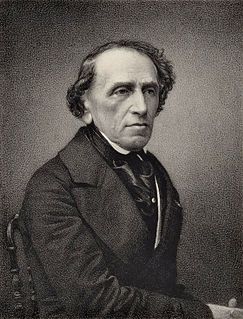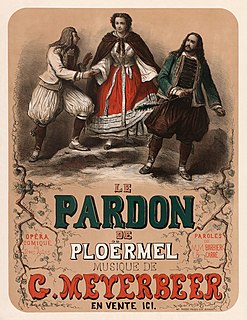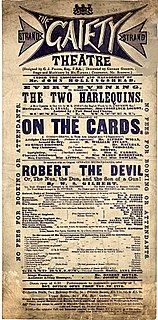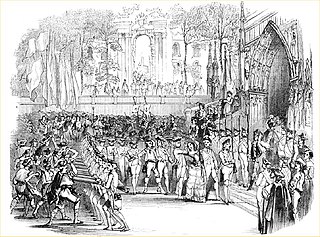
Giacomo Meyerbeer was a German opera composer of Jewish birth, "the most frequently performed opera composer during the nineteenth century, linking Mozart and Wagner". With his 1831 opera Robert le diable and its successors, he gave the genre of grand opera 'decisive character'. Meyerbeer's grand opera style was achieved by his merging of German orchestra style with Italian vocal tradition. These were employed in the context of sensational and melodramatic libretti created by Eugène Scribe and were enhanced by the up-to-date theatre technology of the Paris Opéra. They set a standard which helped to maintain Paris as the opera capital of the nineteenth century.

Augustin Eugène Scribe was a French dramatist and librettist. He is known for writing "well-made plays", a mainstay of popular theatre for over 100 years, and as the librettist of many of the most successful grand operas and opéras-comiques.

Les Huguenots is an opera by Giacomo Meyerbeer and is one of the most popular and spectacular examples of grand opera. In five acts, to a libretto by Eugène Scribe and Émile Deschamps, it premiered in Paris on 29 February 1836.
Samuel Edward Ramey is an American operatic bass-baritone.

Robert the Devil is a legend of medieval origin about a Norman knight who discovers he is the son of Satan. His mother, despairing of heaven's aid in order to obtain a son, had asked for help from the devil. Robert's satanic instincts propel him into a violent and sinful life, but he eventually overcomes them to achieve repentance.

Cornélie Falcon was a French soprano who sang at the Opéra in Paris. Her greatest success was creating the role of Valentine in Meyerbeer's Les Huguenots. She possessed "a full, resonant voice" with a distinctive dark timbre and was an exceptional actress. Based on the roles written for her voice her vocal range spanned from low A-flat to high D, 2.5 octaves. She and the tenor Adolphe Nourrit are credited with being primarily responsible for raising artistic standards at the Opéra, and the roles in which she excelled came to be known as "falcon soprano" parts. She had an exceptionally short career, essentially ending about five years after her debut, when at the age of 23 she lost her voice during a performance of Niedermeyer's Stradella.

Grand opera is a genre of 19th-century opera generally in four or five acts, characterized by large-scale casts and orchestras, and lavish and spectacular design and stage effects, normally with plots based on or around dramatic historic events. The term is particularly applied to certain productions of the Paris Opéra from the late 1820s to around 1850; 'grand opéra' has sometimes been used to denote the Paris Opéra itself.
Robert is a surname and a male given name.

Robert le diable is an opera in five acts composed by Giacomo Meyerbeer between 1827 and 1831, to a libretto written by Eugène Scribe and Germain Delavigne. Robert le diable is regarded as one of the first grand operas at the Paris Opéra. It has only a superficial connection to the medieval legend of Robert the Devil.

L'Africaine is an 1865 French grand opéra in five acts with music by Giacomo Meyerbeer and a libretto by Eugène Scribe. Meyerbeer and Scribe began working on the opera in 1837, using the title L'Africaine, but around 1852 changed the plot to portray fictitious events in the life of the Portuguese explorer Vasco da Gama and introduced the working title Vasco de Gama, the French version of his name. The copying of the full score was completed the day before Meyerbeer died in 1864.

Adolphe Nourrit was a French operatic tenor, librettist, and composer. One of the most esteemed opera singers of the 1820s and 1830s, he was particularly associated with the works of Gioachino Rossini and Giacomo Meyerbeer.

Il crociato in Egitto is an opera in two acts by Giacomo Meyerbeer, with a libretto by Gaetano Rossi. It was first performed at La Fenice theatre, Venice on 7 March 1824. The part of Armando was sung by the famous castrato, Giovanni Battista Velluti; the opera was probably the last written to feature a castrato. It is the last of Meyerbeer's series of operas in Italian, and became the foundation of the composer's international success.

Margherita d'Anjou is an opera semiseria in two acts by Giacomo Meyerbeer. The Italian libretto was by Felice Romani after a text based on legends around the English Wars of the Roses by René-Charles Guilbert de Pixérécourt. The title role is the Queen Margaret of Shakespeare's Henry VI plays, who also appears in Richard III. Margherita d'Anjou is the first opera by Meyerbeer to mix historical events and personages with fictional characters and situations, as his French grand operas Les Huguenots, Le prophète and L'Africaine were later to do. It is the fourth of Meyerbeer's Italian operas and was his first international success.

Pol Henri Plançon was a distinguished French operatic bass. He was one of the most acclaimed singers active during the 1880s, 1890s and early 20th century—a period often referred to as the "Golden Age of Opera".

Victorian burlesque, sometimes known as travesty or extravaganza, is a genre of theatrical entertainment that was popular in Victorian England and in the New York theatre of the mid-19th century. It is a form of parody in which a well-known opera or piece of classical theatre or ballet is adapted into a broad comic play, usually a musical play, usually risqué in style, mocking the theatrical and musical conventions and styles of the original work, and often quoting or pastiching text or music from the original work. Victorian burlesque is one of several forms of burlesque.
This is a selected list of W. S. Gilbert's works, including all that have their own Wikipedia articles. For a complete list of Gilbert's dramatic works, see List of W. S. Gilbert dramatic works.

Dinorah, originally Le pardon de Ploërmel, is an 1859 French opéra comique in three acts with music by Giacomo Meyerbeer and a libretto by Jules Barbier and Michel Carré. The story takes place near the rural town of Ploërmel and is based on two Breton tales by Émile Souvestre, "La Chasse aux trésors" and "Le Kacouss de l'Armor", both published separately in 1850 in the Revue des deux mondes.

Robert the Devil, or The Nun, the Dun, and the Son of a Gun is an operatic parody by W. S. Gilbert of Giacomo Meyerbeer's grand opera Robert le diable, which was named after, but bears little resemblance to, the medieval French legend of the same name. Gilbert set new lyrics to tunes by Meyerbeer, Bellini, Offenbach and others.

Faust is an opera by the German composer Louis Spohr. The libretto, by Joseph Karl Bernard, is based on the legend of Faust; it is not influenced by Goethe's Faust, though Faust, Part One had been published in 1808. Instead, Bernard's libretto draws mainly on Faust plays and poems by Friedrich Maximilian Klinger and Heinrich von Kleist. Spohr's Faust is an important work in the history of German Romantic opera.

The Merry Zingara; Or, The Tipsy Gipsy & The Pipsy Wipsy was the third of W. S. Gilbert's five burlesques of opera. Described by the author as "A Whimsical Parody on The Bohemian Girl", by Michael Balfe, it was produced at the Royalty Theatre, London, on 21 March 1868.
















